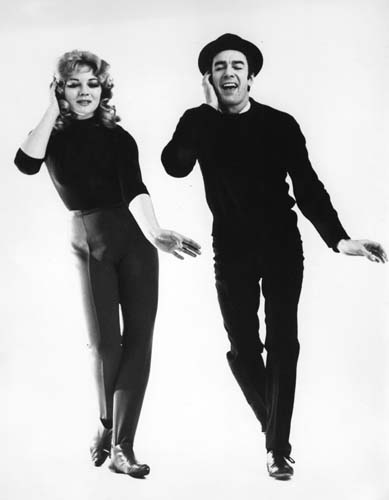
This blogpost is dedicated to all readers involved in folkdancing. And as the title states: it is not the aim to make a monody, on the contrary. Some weeks ago I ordered via the local FNAC store the DVD of ‘Chitty Chitty Bang Bang’, an all time classic from the sixties. A childrens’ movie produced with an astronomical budget, unthinkable or unwanted to remake by today standards. Of course the film is more or less old – fashioned. Exactly the reason why I ordered it. And of course, also because of the dance scenes I remembered so well from a previous viewing. This film holds some of the best dance scenes in the music hall genre I ever saw. Period.
Which is no coïncidence of course. The scenes were filmed when the music hall business was on it’s peak. Trained ballet dancers more often made carreers in this business than in official operahouses. The producer or choreographer could choose form a crowd of male and female dancers and the professional level of performance they were used to, is probably unatainable today. Moreover producers hired the best crew of choreographers, composers, conductors or arrangers availble: The Sherman Brothers for the music and Dee Dee Wood & Marc Breaux for the choreography. The last two were responsible for a gallery of some of the most important dance scènes in American filmhistory: “Mary Poppins”, “The Sound of Music” and of course “Chitty Chitty Bang Bang”.
To have the scenes shot, rehearsals could last for days. Actor Dick Van Dyke (Caracatus Pots, the father-inventor in the film) remembered that some of the most daring scenes had to be repeated a dozen or more times to have them perfect. There always was one dancer tipping over his stick or just turned out of a routine at the wrong moment. A sense of perfection which came not without risks. He remember to end up injured for some weeks, because he didn’t properly warm up like the professional dancers.
“But what has this to do with folkdancing?” you could possibly be asking yourself. Well, about everything. Just remember the ländler scene from the sound of music. All ingredients in this choreography are based on traditional dancing. Of course the whole impression is different, as are the actors or dancers bringing them to life. The attention to detail, variation, humor, etc. is unbelievable. It’s all there. Just take a look at his particular dance scene called “Me ‘Ol Bamboo” from Chitty:
The style is unmistable drawn on the traditional South English morrisdances. But the overall impression is very special. The traditional dancing is lifted to a new level of performance and the result is astounding. Of course most folkdancing ensembles are not used to work with professionals on this level or even ready for the experience, but I surely want to hold a plea for optimism and boundless ambition. Just try it, because it is worth a try all the same. You are working with tradition aren’t you? And for tradition only the best is good enough.
